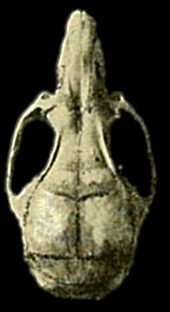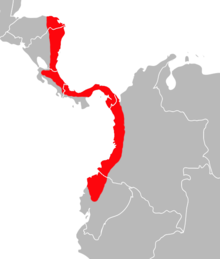Transandinomys bolivaris
| Transandinomys bolivaris | |
|---|---|
 |
|
| Skull from Cerro Azul, Panama, seen from above | |
| Scientific classification | |
| Kingdom: | Animalia |
| Phylum: | Chordata |
| Class: | Mammalia |
| Order: | Rodentia |
| Family: | Cricetidae |
| Genus: | Transandinomys |
| Species: | T. bolivaris |
| Binomial name | |
|
Transandinomys bolivaris (J.A. Allen, 1901) |
|
 |
|
| Distribution of Transandinomys bolivaris in southern Central and northwestern South America | |
| Synonyms | |
|
|
Transandinomys bolivaris, also known as the long-whiskered rice rat, is a rodent in the genus Transandinomys. It is found in humid forest from northeastern Honduras to western Ecuador, up to 1,800 m (5,900 ft) above sea level. Since it was first described in 1901 from Ecuador, six scientific names have been introduced for it, but their common identity was not documented until 1998 and the species has long been known under the name Oryzomys bombycinus, described from Panama in 1912. The name Oryzomys bolivaris was used before it was moved to the new genus Transandinomys with Transandinomys talamancae (formerly Oryzomys talamancae) in 2006.
It is a medium-sized rice rat distinguished by its very long vibrissae (whiskers)—those above the eyes are up to 50 mm (2 in) long. The fur, which is soft and dense, is usually dark brown above and light gray below; it is darker in juveniles. The feet are long and the tail is about as long as the head and body. The skull is narrow and has a broad interorbital region (between the eyes). The species generally lives on the ground. Although it is rare, its conservation status is thought to be secure.
In 1901, Joel Asaph Allen described four new species of rice rat in the genus Oryzomys: three from Ecuador and the Peruvian Oryzomys perenensis. The three Ecuadorian species–Oryzomys bolivaris from Porvenir,Bolívar Province; Oryzomys castaneus from San Javier, Esmeraldas Province; and Oryzomys rivularis from Río Verde, Pichincha Province—were each based on a single specimen collected in 1899 or 1900. He distinguished the three on the basis of coloration, size, and relative tail length.Philip Hershkovitz listed all three among the many synonyms of "Oryzomys laticeps" (currently more narrowly defined as Hylaeamys laticeps) in a 1960 paper.
...
Wikipedia

